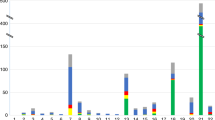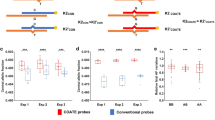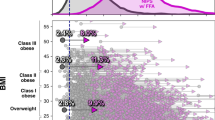Abstract
The trials performed worldwide toward noninvasive prenatal diagnosis (NIPD) of Down's syndrome (or trisomy 21) have shown the commercial and medical potential of NIPD compared to the currently used invasive prenatal diagnostic procedures. Extensive investigation of methylation differences between the mother and the fetus has led to the identification of differentially methylated regions (DMRs). In this study, we present a strategy using the methylated DNA immunoprecipitation (MeDiP) methodology in combination with real-time quantitative PCR (qPCR) to achieve fetal chromosome dosage assessment, which can be performed noninvasively through the analysis of fetal-specific DMRs. We achieved noninvasive prenatal detection of trisomy 21 by determining the methylation ratio of normal and trisomy 21 cases for each tested fetal-specific DMR present in maternal peripheral blood, followed by further statistical analysis. The application of this fetal-specific methylation ratio approach provided correct diagnosis of 14 trisomy 21 and 26 normal cases.
This is a preview of subscription content, access via your institution
Access options
Subscribe to this journal
Receive 12 print issues and online access
$209.00 per year
only $17.42 per issue
Buy this article
- Purchase on Springer Link
- Instant access to full article PDF
Prices may be subject to local taxes which are calculated during checkout



Similar content being viewed by others
References
Hultén, M.A., Dhanjal, S. & Pertl, B. Rapid and simple prenatal diagnosis of common chromosome disorders: advantages and disadvantages of the molecular methods FISH and QF-PCR. Reproduction 126, 279–297 (2003).
Lo, Y.M. et al. Presence of fetal DNA in maternal plasma and serum. Lancet 350, 485–487 (1997).
Honda, H. et al. Fetal gender determination in early pregnancy through qualitative and quantitative analysis of fetal DNA in maternal serum. Hum. Genet. 110, 75–79 (2002).
Bianchi, D.W., Avent, N.D., Costa, J.M. & van der Schoot, C.E. Noninvasive prenatal diagnosis of fetal Rhesus D: ready for prime(r) time. Obstet. Gynecol. 106, 841–844 (2005).
Lo, Y.M. et al. Prenatal diagnosis of fetal RhD status by molecular analysis of maternal plasma. N. Engl. J. Med. 339, 1734–1738 (1998).
Lo, Y.M. et al. Quantitative analysis of fetal DNA in maternal plasma and serum: implications for noninvasive prenatal diagnosis. Am. J. Hum. Genet. 62, 768–775 (1998).
Chan, K.C. et al. Size distributions of maternal and fetal DNA in maternal plasma. Clin. Chem. 50, 88–92 (2004).
Poon, L.L., Leung, T.N., Lau, T.K., Chow, K.C. & Lo, Y.M. Differential DNA methylation between fetus and mother as a strategy for detecting fetal DNA in maternal plasma. Clin. Chem. 48, 35–41 (2002).
Chim, S.S. et al. Detection of the placental epigenetic signature of the maspin gene in maternal plasma. Proc. Natl. Acad. Sci. USA 102, 14753–14758 (2005).
Chiu, R.W. et al. Hypermethylation of RASSF1A in human and rhesus placentas. Am. J. Pathol. 170, 941–950 (2007).
Old, R.W., Crea, F., Puszyk, W. & Hulten, M.A. Candidate epigenetic biomarkers for non-invasive prenatal diagnosis of Down syndrome. Reprod. Biomed. Online 15, 227–235 (2007).
Chim, S.S. et al. Systematic search for placental DNA-methylation markers on chromosome 21: toward a maternal plasma-based epigenetic test for fetal trisomy 21. Clin. Chem. 54, 500–511 (2008).
Fazzari, M.J. & Greally, J.M. Epigenomics: beyond CpG islands. Nat. Rev. Genet. 5, 446–455 (2004).
Grunau, C., Clark, S.J. & Rosenthal, A. Bisulfite genomic sequencing: systematic investigation of critical experimental parameters. Nucleic Acids Res. 29, E65 (2001).
Rakyan, V.K. et al. An integrated resource for genome-wide identification and analysis of human tissue-specific differentially methylated regions (tDMRs). Genome Res. 18, 1518–1529 (2008).
Papageorgiou, E.A. et al. Sites of differential DNA methylation between placenta and peripheral blood: molecular markers for noninvasive prenatal diagnosis of aneuploidies. Am. J. Pathol. 174, 1609–1618 (2009).
Weber, M. et al. Chromosome-wide and promoter-specific analyses identify sites of differential DNA methylation in normal and transformed human cells. Nat. Genet. 37, 853–862 (2005).
Lo, Y.M. et al. Plasma placental RNA allelic ratio permits noninvasive prenatal chromosomal aneuploidy detection. Nat. Med. 13, 218–223 (2007).
Wald, N.J., Watt, H.C. & Hackshaw, A.K. Integrated screening for Down's syndrome on the basis of tests performed during the first and second trimesters. N. Engl. J. Med. 341, 461–467 (1999).
Weisz, B. & Rodeck, C.H. An update on antenatal screening for Down's syndrome and specific implications for assisted reproduction pregnancies. Hum. Reprod. Update 12, 513–518 (2006).
Chiu, R.W. et al. Noninvasive prenatal diagnosis of fetal chromosomal aneuploidy by massively parallel genomic sequencing of DNA in maternal plasma. Proc. Natl. Acad. Sci. USA 105, 20458–20463 (2008).
Fan, H.C., Blumenfeld, Y.J., Chitkara, U., Hudgins, L. & Quake, S.R. Noninvasive diagnosis of fetal aneuploidy by shotgun sequencing DNA from maternal blood. Proc. Natl. Acad. Sci. USA 105, 16266–16271 (2008).
Chiu, R.W. et al. Maternal plasma DNA analysis with massively parallel sequencing by ligation for noninvasive prenatal diagnosis of trisomy 21. Clin. Chem. 56, 459–463 (2010).
Tsui, N.B. et al. Detection of trisomy 21 by quantitative mass spectrometric analysis of single-nucleotide polymorphisms. Clin. Chem. 51, 2358–2362 (2005).
Tsui, N.B. & Lo, Y.M. A microarray approach for systematic identification of placental-derived RNA markers in maternal plasma. Methods Mol. Biol. 444, 275–289 (2008).
Tong, Y.K. et al. Noninvasive prenatal detection of trisomy 21 by an epigenetic-genetic chromosome-dosage approach. Clin. Chem. 56, 90–98 (2010).
Tsui, N.B. et al. Non-invasive prenatal detection of fetal trisomy 18 by RNA-SNP allelic ratio analysis using maternal plasma SERPINB2 mRNA: a feasibility study. Prenat. Diagn. 29, 1031–1037 (2009).
Acknowledgements
E.A.P. and P.C.P. were supported by the Special Non-Invasive Advances in Fetal and Neonatal Evaluation Network of Excellence European Commission Funded 6th Framework Package Project Number: LSHB-CT-2004-503243 and the Cyprus Institute of Neurology and Genetics. A.K. was supported by the University of Cyprus. E.T. was supported by the State Scholarships Foundation of Greece. V.V. was supported by the Mitera Hospital in Athens. N.C. was supported by the Wellcome Trust. We thank C. Sismani, L. Kousoulidou and G. Koumbaris for extensive discussions, as well as M. Hulten for her encouragement to initiate this project.
Author information
Authors and Affiliations
Contributions
E.A.P. and E.T. carried out the experiments. E.A.P. wrote the manuscript. E.A.P. and A.K. performed the statistical analysis. E.T. and V.V. collected the majority of the samples in this study. N.P.C. provided input on the selection of the DMRs. P.C.P. was the principal investigator and has supervised the project. All authors reviewed, critiqued and offered comments on the text.
Corresponding author
Ethics declarations
Competing interests
P.C.P. and E.A.P. have filed a US provisional patent for the fetal-specific DNA methylation ratio approach (application no. 61/405,421).
Supplementary information
Supplementary Text and Figures
Supplementary Tables 1–6, Supplementary Data and Supplementary Methods (PDF 174 kb)
Rights and permissions
About this article
Cite this article
Papageorgiou, E., Karagrigoriou, A., Tsaliki, E. et al. Fetal-specific DNA methylation ratio permits noninvasive prenatal diagnosis of trisomy 21. Nat Med 17, 510–513 (2011). https://doi.org/10.1038/nm.2312
Received:
Accepted:
Published:
Issue Date:
DOI: https://doi.org/10.1038/nm.2312
This article is cited by
-
First trimester combined screening test for aneuploidies in anti-Ro carriers pregnant women
Clinical Rheumatology (2021)
-
Identification of fetal unmodified and 5-hydroxymethylated CG sites in maternal cell-free DNA for non-invasive prenatal testing
Clinical Epigenetics (2020)
-
Evaluation of extraction methods for methylated cell-free fetal DNA from maternal plasma
Journal of Assisted Reproduction and Genetics (2018)
-
Intrauterine growth retardation-associated syncytin b hypermethylation in maternal rat blood revealed by DNA methylation array analysis
Pediatric Research (2017)
-
Circulating DNA addresses cancer monitoring in non small cell lung cancer patients for detection and capturing the dynamic changes of the disease
SpringerPlus (2016)



